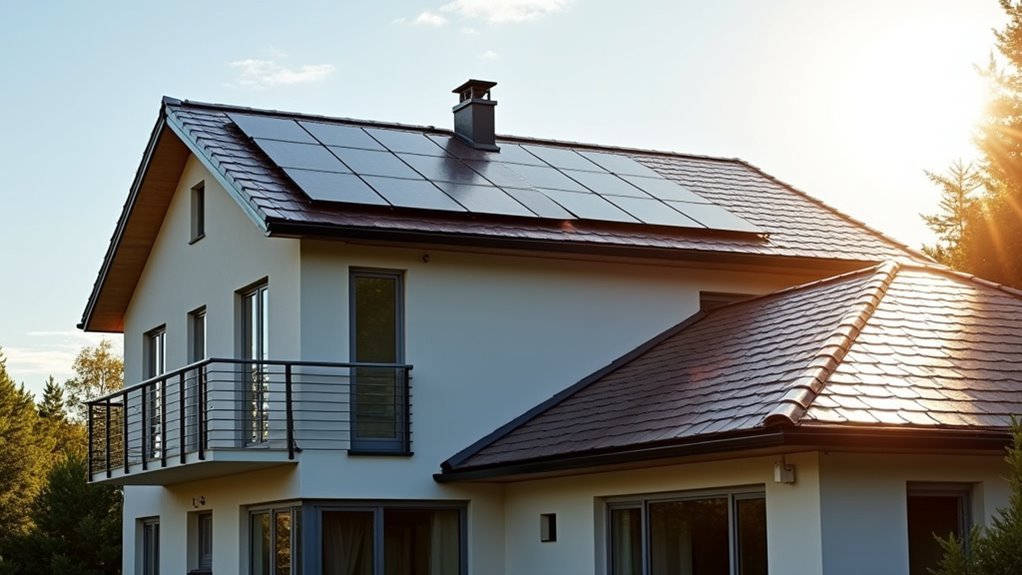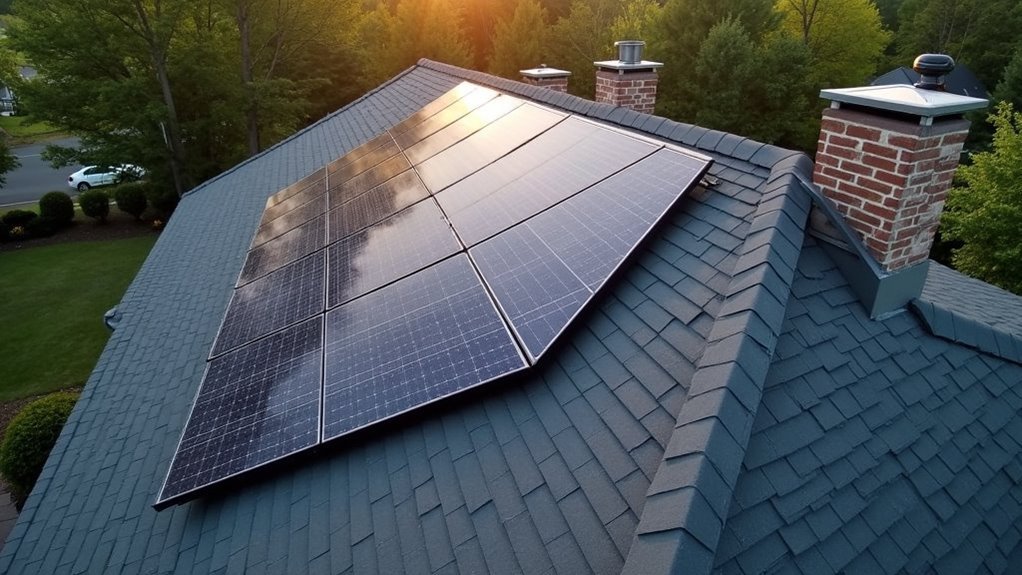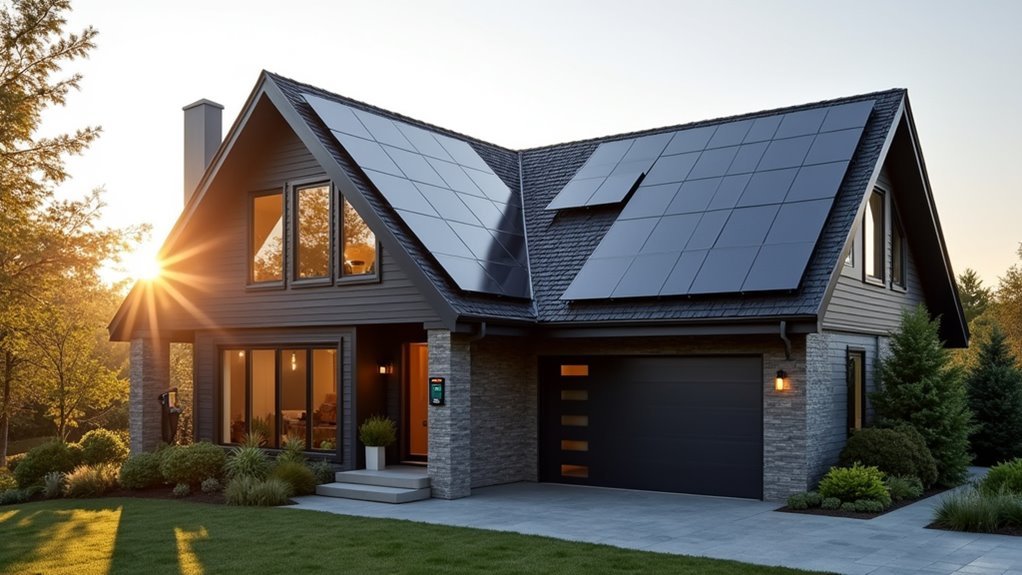Modern solar roofing systems offer you three distinct choices in 2025: Tesla’s fully integrated Solar Roof V4.0, GAF Energy’s Timberline Solar shingles, and flexible solar panel overlays. Each system delivers 25-30% energy conversion efficiency with smart monitoring capabilities and 25-year warranties. Your ideal choice depends on factors like architectural style, budget, and energy needs. Tesla provides premium integration, GAF excels in traditional aesthetics, and flexible panels offer versatile applications. A detailed analysis of specifications and ROI will guide your selection.
Understanding Solar Roofing Technology in 2025

As solar technology continues to evolve, 2025’s residential solar roofing systems have transformed into sophisticated power-generating networks that integrate seamlessly with home energy management systems. You’ll find that current solar cell efficiency has reached unprecedented levels, with most panels now converting 25-30% of sunlight into usable electricity.
Among the leading rooftop solar trends, you’ll notice the widespread adoption of bifacial panels that capture reflected light from both sides, maximizing energy production. Smart monitoring systems now provide real-time performance analytics, helping you optimize power generation based on weather patterns and usage habits. The integration of micro-inverters at individual panel levels guarantees you won’t lose entire system functionality if one panel underperforms, while advanced energy storage solutions let you maintain power during grid outages.
Tesla Solar Roof: The Premium Integrated Solution
While traditional solar panels mount onto existing roofs, Tesla’s Solar Roof V4.0 replaces your entire roofing system with photovoltaic tiles that blend seamlessly into the architectural design. The system’s integrated aesthetics eliminate the visual disruption of conventional panels while maintaining peak energy production efficiency.
You’ll find the customizable design allows for optimization based on your home’s specific energy needs and architectural style. The V4.0 features advanced microinverter technology embedded within each tile, maximizing power output even in partial shade conditions. Tesla’s proprietary weather barrier system provides superior protection against leaks and wind uplift, meeting the most stringent building codes.
The installation includes a detailed home energy management system that integrates with Tesla’s Powerwall, enabling real-time monitoring and automated power distribution throughout your home.
GAF Energy’s Timberline Solar: Traditional Aesthetics Meet Innovation

GAF Energy’s Timberline Solar system represents another breakthrough in integrated solar roofing technology, offering homeowners a more traditional architectural aesthetic compared to Tesla’s sleek modern design. The system integrates nailable solar shingles directly into conventional roofing materials, maintaining familiar solar roof aesthetics while delivering substantial power generation.
You’ll find the Timberline Solar system excels in solar roof durability, featuring a design that withstands winds up to 130 mph and impact ratings that match standard shingles. The system’s water-shedding capabilities mirror traditional roofing materials, ensuring long-term protection. Installation follows standard roofing procedures, allowing certified contractors to complete the work using familiar techniques and tools. This approach considerably reduces installation complexity and time while maintaining the dimensional appearance of conventional asphalt shingles that many homeowners prefer.
Flexible Solar Panel Systems and Their Applications
Flexible solar panels offer you distinct mounting advantages for curved surfaces and lightweight applications, though they typically deliver 10-15% less energy efficiency compared to rigid panels. You’ll find these systems particularly valuable for RVs, boats, and non-traditional roof designs where standard panels aren’t practical, with installation costs averaging 15-20% less than traditional systems. The cost-to-performance ratio becomes most favorable when your installation priorities include weight restrictions or aesthetic conformity to curved surfaces, despite the lower power output per square foot.
Mounting Benefits and Limitations
When you’re considering mounting options for solar panels, flexible systems offer distinct advantages that set them apart from traditional rigid installations. You’ll find they conform to curved surfaces and require minimal structural modifications to your roof, reducing installation complexity and costs.
However, you must consider several installation limitations. Flexible panels typically need a smooth, continuous surface for ideal adhesion, and they’re more susceptible to wind uplift than mechanically fastened systems. Durability considerations include potential delamination over time and reduced heat dissipation compared to raised mounting systems.
You’ll achieve optimal results by ensuring your roof meets specific criteria: minimal shade coverage, proper pitch angle, and adequate structural integrity. While flexible mounting systems excel in weight reduction and aesthetics, they’ll require careful planning to optimize their performance potential.
Cost Vs Performance Analysis
How do flexible solar panels stack up against traditional rigid systems with respect to cost-effectiveness? While flexible panels typically cost 10-15% less upfront, their efficiency ratings average 16-18% compared to rigid panels’ 20-23%. Your payback period analysis needs to account for this performance gap.
You’ll find that flexible systems generate approximately 25% less power per square foot, extending your energy cost savings timeline. However, their adaptability to curved surfaces and lighter weight can offset these limitations in specific applications. A 5kW flexible system might save you $800-1,000 annually on electricity bills, compared to $1,100-1,300 for traditional panels. When calculating ROI, consider that flexible panels generally last 15-20 years, while rigid systems often exceed 25 years of reliable operation.
Cost Analysis and Return on Investment

Your initial investment in solar roofing typically ranges from $15,000 to $35,000, depending on system size, material quality, and installation complexity. You’ll recover these costs through reduced energy bills, federal tax incentives (30% credit as of 2025), and state-specific rebates that combine to accelerate your payback period. Based on current energy prices and system efficiency ratings, you can expect a return on investment within 5-8 years, after which your solar roof will generate virtually free electricity for the remainder of its 25-30 year lifespan.
Initial Costs Breakdown
Understanding the initial investment for solar roofing requires a detailed breakdown of costs and potential returns. You’ll face several upfront expenses: materials ($15,000-$25,000), installation costs ($5,000-$10,000), and permits ($500-$1,500). These figures vary based on your home’s size and location.
The system components contribute drastically to your total investment: solar panels ($200-$400 per panel), inverters ($1,000-$2,500), mounting hardware ($500-$2,000), and wiring ($1,000-$1,500). Labor typically accounts for 25-35% of the project cost. Your payback period generally ranges from 5-10 years, depending on local energy rates and available incentives. Factor in extra costs for roof reinforcement ($500-$1,500) and electrical system upgrades ($800-$2,000) to guarantee a thorough budget assessment.
Long-Term Financial Benefits
Investing in solar roofing delivers substantial financial returns over time through multiple revenue streams and cost reductions. You’ll experience significant long term savings through reduced electricity bills, tax incentives, and potential energy credits. The lifetime value of solar roofing typically exceeds traditional options by 200-300% over 25 years.
| Benefit Category | Annual Savings |
|---|---|
| Energy Bills | $1,500-$2,500 |
| Tax Credits | $500-$1,000 |
| Net Metering | $300-$800 |
| Maintenance Costs | $200-$400 |
| Property Value | $15,000-$25,000* |
*One-time increase
Your investment becomes cash-flow positive within 5-7 years, depending on your location and energy consumption patterns. The system’s sophisticated monitoring technology helps you track real-time performance and optimize energy generation, ensuring maximum financial returns throughout the solar roof’s 25-30 year lifespan.
Federal Incentives and State-Specific Benefits
While solar installation costs remain considerable, substantial federal and state incentives can dramatically reduce your total investment in 2025. The federal solar Investment Tax Credit (ITC) allows you to deduct 30% of your installation costs from your federal taxes, provided you meet incentive program eligibility requirements.
Your state’s net metering policies can further augment your savings by crediting your utility bill for excess power generation. States like California, New York, and Massachusetts offer additional tax breaks, discounts, and Solar Renewable Energy Credits (SRECs). You’ll need to verify your local jurisdiction’s specific offerings, as they vary extensively by region. Some states provide performance-based incentives, calculating your benefits based on actual energy production, while others offer upfront rebates that reduce initial costs.
Installation Process and Timeline Expectations
Before your solar installation begins, a thorough site assessment and planning phase typically spans 2-4 weeks. During this period, engineers evaluate your roof’s structural integrity, sun exposure, and electrical requirements to design an ideal system layout.
The permitting process follows, taking 3-6 weeks as your contractor coordinates with local authorities to secure necessary approvals. Once permits are obtained, the physical installation usually requires 2-3 days for residential systems, involving roof preparation, mounting hardware installation, and panel placement.
Your contractor coordination will include scheduling electrical inspections and utility company reviews, which can add 1-2 weeks to the timeline. The final step involves connecting your system to the power grid and activating monitoring systems. You can expect the entire process, from initial assessment to full operation, to take 8-12 weeks.
Maintenance Requirements and Warranty Coverage
To optimize your solar roofing system’s longevity, you’ll need to follow a structured maintenance protocol that includes quarterly visual inspections and initial professional assessments. Your maintenance schedules should incorporate debris removal, connection checks, and performance monitoring through your system’s digital interface.
Most manufacturers offer 25-year warranty terms on solar roofing components, covering both material defects and power output guarantees. You’ll typically find tiered coverage, with extensive protection during the initial 10 years and graduated coverage for the remaining period. To maintain valid warranty terms, you must document all maintenance activities and use certified technicians for repairs. Performance monitoring systems automatically log operational data, helping you track efficiency and identify potential issues before they affect your warranty coverage.
Frequently Asked Questions
Can Solar Panels Be Installed on a North-Facing Roof Section?
While you can technically install solar panels on a north-facing roof, it’s not advised due to notably diminished energy conversion efficiency. You’ll experience up to 30% less power generation compared to preferred south-facing installation positioning. If you’re restricted to north-facing sections, you’ll need to examine alternative solutions like adjustable mounting brackets or ground-mounted systems to attain superior solar exposure and optimize your system’s performance.
What Happens to Solar Roofing During Extended Power Outages?
During extended power outages, your grid-tied solar system will automatically shut down for safety reasons, even if the sun’s shining. Without a battery backup system, you won’t have power despite your solar panels. If you’ve installed battery storage, you’ll continue receiving electricity from your stored energy. For uninterrupted power, you’ll need a solar system with automatic transfer switches and dedicated backup circuits to isolate your home from the grid during outages.
How Do Extreme Weather Conditions Like Hail Affect Solar Roof Warranties?
Most solar roof warranties specifically address extreme weather impacts, including hail damage. You’ll find that manufacturers typically guarantee their panels to withstand hailstones up to 1 inch in diameter at speeds of 50+ mph. Your warranty’s coverage for solar roof durability often encompasses protection against structural damage, but you’ll need to verify specific terms. If hail exceeds these parameters, your homeowner’s insurance may provide supplementary coverage where the manufacturer’s warranty concludes.
Can I Install a Satellite Dish or Antenna on My Solar Roof?
You’ll need to carefully consider both technical and aesthetic considerations before installing a satellite dish or antenna on your solar roof. While it’s possible, you must guarantee proper structural reinforcement to support the supplementary weight and prevent damage to the solar panels. You’ll want to work with both your solar installer and satellite technician to determine ideal placement that won’t create shadows on panels or compromise your system’s effectiveness.
Are There Special Insurance Requirements for Homes With Solar Roofing Systems?
You’ll need to update your homeowner’s insurance policy to specifically cover your solar roofing system. Most insurance providers require supplemental coverage requirements due to the system’s value and potential risks. When reviewing policy considerations, guarantee your coverage includes protection against weather damage, electrical malfunctions, and theft. You’ll also want to verify if your installer’s workmanship warranty aligns with your insurance coverage requirements for complete protection.





